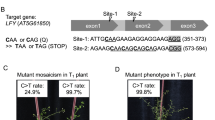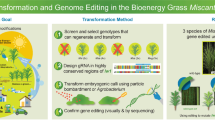Abstract
Transgene expression and genome editing can help improve cucumber varieties to better respond to climate change. This study aimed to evaluate the applicability of the CsUBL5 promoter in transgene expression and genome editing in cucumber. The CsUBL5 promoter was cloned and analyzed to identify cis-elements that respond to abiotic signals, hormones, signal molecules, and nutrient treatments. 5′ deletion constructs of the promoter were tested for their ability to drive GUS reporter expression in cucumber cotyledons, Arabidopsis seedlings, and tobacco leaves, and their response to various treatments including SA, light, drought, IAA, and GA was determined. The results showed that the CsUBL5 promoter effectively drove transgene expression in these plants, and their expressions under treatments were consistent with the predicted cis-elements, with some exceptions. Furthermore, the pCsUBL5-749 deletion construct can improve genome editing efficiency in cucumber when driving Cas9 expression. The editing efficiency of two sgRNAs targeting the ATG6 gene in cucumber was up to 4.6-fold higher using pCsUBL5-749 compared to a rice UBI promoter, although the effects of changing promoter on the editing efficiency is sgRNA specific. These findings highlight the potential utility of the CsUBL5 promoter for improving cucumber varieties through genetic engineering and genome editing. It also demonstrates the importance of modulating Cas9 expression to increase genome editing efficiency in cucumbers.




Similar content being viewed by others
References
Aslanidis C, de Jong P (1990) Ligation-independent cloning of PCR products (LIC-PCR). Nucleic Acids Res. https://doi.org/10.1093/nar/18.20.6069
Baumann K, De Paolis A, Costantino P, Gualberti G (1999) The DNA binding site of the Dof protein NtBBF1 is essential for tissue-specific and auxin-regulated expression of the rolB oncogene in plants. Plant Cell 11:323–334. https://doi.org/10.1105/tpc.11.3.323
Berumen-Varela G, Ochoa-Jiménez VA, Burgara-Estrella A et al (2018) Functional analysis of a tomato (Solanum lycopersicum L.) rhamnogalacturonan lyase promoter. J Plant Physiol 229:175–184. https://doi.org/10.1016/j.jplph.2018.08.002
Bortesi L, Fischer R (2015) The CRISPR/Cas9 system for plant genome editing and beyond. Biotechnol Adv 33:41–52. https://doi.org/10.1016/j.biotechadv.2014.12.006
Bradford MM (1976) A rapid and sensitive method for the quantitation of microgram quantities of protein utilizing the principle of protein-dye binding. Anal Biochem 72:248–254. https://doi.org/10.1016/0003-2697(76)90527-3
Chandrasekaran J, Brumin M, Wolf D et al (2016) Development of broad virus resistance in non-transgenic cucumber using CRISPR/Cas9 technology. Mol Plant Pathol 17:1140–1153. https://doi.org/10.1111/mpp.12375
Chen S, Songkumarn P, Liu J, Wang GL (2009) A versatile zero background T-vector system for gene cloning and functional genomics. Plant Physiol 150:1111–1121. https://doi.org/10.1104/pp.109.137125
Chen B, Lin L, Lu Y et al (2020) Ubiquitin-Like protein 5 interacts with the silencing suppressor p3 of rice stripe virus and mediates its degradation through the 26S proteasome pathway. PLoS Pathog 16:e1008780. https://doi.org/10.1371/journal.ppat.1008780
Feng Z, Zhang B, Ding W et al (2013) Efficient genome editing in plants using a CRISPR/Cas system. Cell Res 23:1229–1232. https://doi.org/10.1038/cr.2013.114
Higo K, Ugawa Y, Iwamoto M, Korenaga T (1999) Plant cis-acting regulatory DNA elements (PLACE) database: 1999. Nucleic Acids Res 27:297–300. https://doi.org/10.1093/nar/27.1.297
Hu B, Li D, Liu X et al (2017) Engineering non-transgenic gynoecious cucumber using an improved transformation protocol and optimized CRISPR/Cas9 system. Mol Plant 10:1575–1578. https://doi.org/10.1016/j.molp.2017.09.005
Jefferson RA (1987) Assaying chimeric genes in plants: the GUS gene fusion system. Plant Mol Biol Rep 5:387–405. https://doi.org/10.1007/BF02667740
Jiang P, Zhang K, Ding Z et al (2018) Characterization of a strong and constitutive promoter from the Arabidopsis serine carboxypeptidase-like gene AtSCPL30 as a potential tool for crop transgenic breeding. BMC Biotechnol 18:1–13. https://doi.org/10.1186/s12896-018-0470-x
Lescot M, Déhais P, Thijs G et al (2002) PlantCARE, a database of plant cis-acting regulatory elements and a portal to tools for in silico analysis of promoter sequences. Nucleic Acids Res 30:325–327. https://doi.org/10.1093/nar/30.1.325
Li XF, Li SQ, Sun YD et al (2022) Isolation and functional validation of the VvZFP11 promoter associated with a signaling molecule and powdery mildew responses in grapevine. Sci Hortic 298:11098. https://doi.org/10.1016/j.scienta.2022.110980
Liu J, Wang F, Yu G et al (2015) Functional analysis of the Maize C-repeat/DRE motif-binding transcription factor CBF3 promoter in response to abiotic stress. Int J Mol Sci 16:12131–12146. https://doi.org/10.3390/ijms160612131
Long L, Guo DD, Gao W et al (2018) Optimization of CRISPR/Cas9 genome editing in cotton by improved sgRNA expression. Plant Methods 14:85. https://doi.org/10.1186/s13007-018-0353-0
Mao Y, Zhang H, Xu N et al (2013) Application of the CRISPR-Cas system for efficient genome engineering in plants. Mol Plant 6:2008–2011. https://doi.org/10.1093/mp/sst121
Masura SS, Parveez GK, Ismail I (2010) Isolation and characterization of oil palm constitutive promoter derived from ubiquitin extension protein (uep1) gene. N Biotechnol 27:289–299. https://doi.org/10.1016/j.nbt.2010.01.337
Patel M, Milla-Lewis S, Zhang W et al (2015) Overexpression of ubiquitin-like LpHUB1 gene confers drought tolerance in perennial ryegrass. Plant Biotechnol J 13:689–699. https://doi.org/10.1111/pbi.12291
Petolino JF, Davies JP (2013) Designed transcriptional regulators for trait development. Plant Sci 201–202:128–136. https://doi.org/10.1016/j.plantsci.2012.12.006
Podia V, Chatzopoulos D, Milioni D (2023) GUS reporter-aided promoter deletion analysis of A. thaliana POLYAMINE OXIDASE 3. Int J Mol Sci 24:2317. https://doi.org/10.3390/ijms24032317
Schloss PD, Westcott SL, Ryabin T et al (2009) Introducing mothur: open-source, platform-independent, community-supported software for describing and comparing microbial communities. Appl Environ Microbiol 75:7537–7541. https://doi.org/10.1128/AEM.01541-09
Sengupta S, Pehlivan N, Mangu V, Rajasekaran K, Baisakh N (2022) Characterization of a Stress-enhanced promoter from the grass halophyte, Spartina alterniflora L. Biology 11:1828. https://doi.org/10.3390/biology11121828
Tao YB, He LL, Niu LJ, Xu ZF (2014) Isolation and characterization of an ubiquitin extension protein gene (JcUEP) promoter from Jatropha curcas. Planta 241:823–836. https://doi.org/10.1007/s00425-014-2222-z
Tek MI, Calis O, Fidan H et al (2022) CRISPR/Cas9 based mlo-mediated resistance against Podosphaera xanthii in cucumber (Cucumis sativus L.). Front Plant Sci 13:1081506. https://doi.org/10.3389/fpls.2022.1081506
Wang F, Gao ZH, Qiao YS et al (2014) RdreB1BI gene expression driven by the stress-induced promoter rd29a enhances tolerance to cold stress in benihope strawberry. Acta Hortic 1049:975–988. https://doi.org/10.17660/ActaHortic.2014.1049.159
Wang C, Gao G, Cao S, Xie Q, Qi H (2019) Isolation and functional validation of the CmLOX08 promoter associated with signalling molecule and abiotic stress responses in oriental melon, Cucumis melo var. makuwa Makino. BMC Plant Biol 19:75. https://doi.org/10.1186/s12870-019-1678-1
Watanabe E, Mano S, Nishimura M, Yamada K (2019) AtUBL5 regulates growth and development through pre-mRNA splicing in Arabidopsis thaliana. PLoS ONE 14:e0224795. https://doi.org/10.1371/journal.pone.0224795
Wu HY, Liu KH, Wang YC et al (2014) AGROBEST: an efficient Agrobacterium-mediated transient expression method for versatile gene function analyses in Arabidopsis seedlings. Plant Methods 10:19. https://doi.org/10.1186/1746-4811-10-19
Xie K, Minkenberg B, Yang Y (2014) Targeted gene mutation in rice using a CRISPR-Cas9 system. Bio-Protoc 4:e1225–e1225. https://doi.org/10.21769/BioProtoc.1225
Xie K, Minkenberg B, Yang Y (2015) Boosting CRISPR/Cas9 multiplex editing capability with the endogenous tRNA-processing system. Proc Natl Acad Sci 112:3570–3575. https://doi.org/10.1073/pnas.1420294112
Xing Q, Liao J, Cao S et al (2020) CmLOX10 positively regulates drought tolerance through jasmonic acid -mediated stomatal closure in oriental melon (Cucumis melo var. makuwa Makino). Sci Rep 10:17452. https://doi.org/10.1038/s41598-020-74550-7
Xu R, Li H, Qin R et al (2014) Gene targeting using the Agrobacterium tumefaciens-mediated CRISPR-Cas system in rice. Rice 7:5. https://doi.org/10.1186/s12284-014-0005-6
Zhan Y, Sun X, Rong G et al (2017) Identification of two transcription factors activating the expression of OsXIP in rice defence response. BMC Biotechnol 17:26. https://doi.org/10.1186/s12896-017-0344-7
Zhao H, Tan Z, Wen X, Wang Y (2017) An improved syringe agroinfiltration protocol to enhance transformation efficiency by combinative use of 5-azacytidine, ascorbate acid and tween-20. Plants 6:9. https://doi.org/10.3390/plants6010009
Acknowledgements
This research is supported by the Graduate Program Scholarship from The Graduate School, Kasetsart University for KT. ID was supported by Science Achievement Scholarship of Thailand (SAST). AS was supported by Agricultural Research Development Agency (CRP6405030740). SV was supported by the National Research Council of Thailand (NRCT5-RSA63002-02) and The Office of the Ministry of Higher Education, Science, Research and Innovation; and the Thailand Science Research and Innovation through the Kasetsart University Reinventing University Program 2021. Dr. Thidaporn Supapakorn, Dr. Passorn Wonnapinij, and Kunnika Thongrak provided assistance in data and statistical analysis.
Author information
Authors and Affiliations
Contributions
AS, KT, and SV conceived the project and designed experiments. KT and ID performed the experiments. KT, ID and AS analyzed the data. KT, ID, SV, and AS prepared Figures and Tables and wrote the manuscript. All authors have reviewed the manuscript and approved the final version.
Corresponding author
Ethics declarations
Conflict of interest
The authors declare that there are no conflicts of interest.
Additional information
Publisher's Note
Springer Nature remains neutral with regard to jurisdictional claims in published maps and institutional affiliations.
Supplementary Information
Below is the link to the electronic supplementary material.
Rights and permissions
Springer Nature or its licensor (e.g. a society or other partner) holds exclusive rights to this article under a publishing agreement with the author(s) or other rightsholder(s); author self-archiving of the accepted manuscript version of this article is solely governed by the terms of such publishing agreement and applicable law.
About this article
Cite this article
Taway, K., Dachphun, I., Vuttipongchaikij, S. et al. Evaluation of cucumber UBL5 promoter as a tool for transgene expression and genome editing in plants. Transgenic Res 32, 437–449 (2023). https://doi.org/10.1007/s11248-023-00359-5
Received:
Accepted:
Published:
Issue Date:
DOI: https://doi.org/10.1007/s11248-023-00359-5




